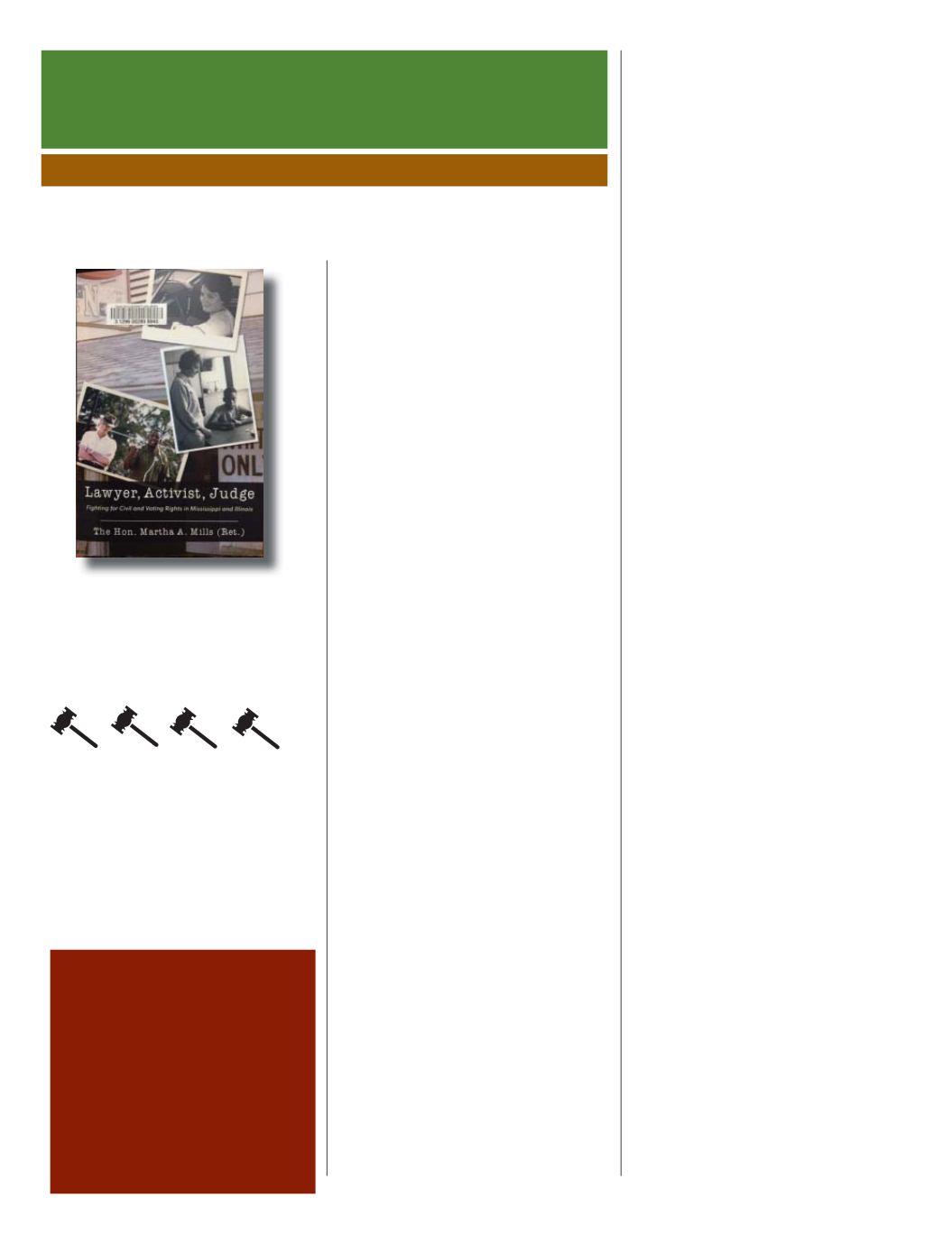

SUMMARY
JUDGMENTS
REVIEWS, REVIEWS, REVIEWS!
Keeping the Flame
Lawyer, Activist, Judge: Fighting for Civil
and Voting Rights in Mississippi and Illinois
By Judge Martha A. Mills (Ret.)
ABA Publishing, 2015
Reviewed by Daniel A. Cotter
D
uring the 1960’s, many in the
South (particularly inMississippi)
tried to prevent the civil rights
movement from developing a stronghold.
However, many from outside the region
who were “courageous and gutsy” left the
Daniel A. Cotter is a Partner
at Butler Rubin Saltarelli &
Boyd LLP, where he chairs
the Insurance Regulatory and
Transactions practice. He is a
member of the CBA Record
Editorial Boardand Immediate
Past President of the CBA.
comforts of their homes to fight for civil
rights and justice, putting themselves at
great personal risk. The Honorable Martha
Mills (ret.) was one of those courageous
individuals.
In her new book,
Lawyer, Activist, Judge:
Fighting for Civil and Voting Rights in Mis-
sissippi and Illinois,
Mills tells her story of
leaving a major Wall Street law firm, where
she was a young associate, to join the Law-
yers’ Committee for Civil Rights Under
Law. Justice Michael Hyman addresses
Mills’ work and her courage during her
time with the Committee in his Foreword:
Judge Martha Mills (ret.) is an
authentic lawyer-hero, a courageous
trailblazer, and an enduring source of
inspiration for those who know her
accomplishments during the tense
years of the civil rights movement.
She participated in the events that
changed the fundamental character
of these United States.
At a time when few women lawyers
and fewer women trial lawyers were
in the profession, Martha boldly
challenged the racial status quo and
racial barrier in the South.
Mills’ original plan was to go to Jackson,
Mississippi for one month, then return to
private practice at the White & Case law
firm. However, she was “so appalled at what
was happening that she returned a month
later as a permanent staff member” of the
Lawyers’ Committee. The book opens with
a description of Mills’ birthday, May 11,
1967, a night Mills was out for a walk in
Jackson and noticed a military tank headed
her way. Later than night, Mills witnessed
the death of civil rights activist Ben Brown.
This chilling opening sets the stage for the
story of Mills’ journey.
Mills describes her college years at
Macalester College and her subsequent
legal studies at the University of Minne-
sota. She then explains the creation of the
Lawyers’ Committee for Civil Rights Under
Law and introduces the reader to some of
the pioneering civil rights lawyers. Mills
then explains the challenges that African
Americans faced in registering to vote and
in actually casting ballots. Poll taxes, literacy
tests, governmental knowledge tests and
other discriminatory tests were designed
to keep African Americans from exercising
their voting power in Mississippi.
Mills includes in her book a number
of letters she wrote home during her time
in Mississippi. Although her family was
concerned about her safety and her rejec-
tion of a lucrative law firm position, Mills
remained steadfast and committed to doing
the Committee work.
Mills describes the trials, victories,
defeats, and challenges associated with her
work. She recalls the humor that Com-
mittee members displayed in “fighting the
good fight” and explains the prejudice and
discrimination that she said was embod-
ied in federal Judge William Harold Cox
in the Southern District of Mississippi.
She explains her suspension as a lawyer
in Mississippi, a frequent tactic that the
Mississippi Bar Association andMississippi
judges used to prevent civil rights lawyers
from being able to do their work. Mills
closes the description of her time in Jackson
by quoting from Charles Evers’ memoirs,
in which he noted:
The hardest thing I had to do was to
fire our city attorney, Martha Wood,
for breaking the miscegenation law.
MarthaWood was a white woman, a
good lawyer who backed civil rights.
Around 1969, she fell in love with a
local Negro cop named Jenkins.They
married and tried to live in Fayette.
Mills moved to Cairo, Illinois (pro-
nounced “’care-oh’ or ‘kay-ro’”) in 1969
and continued her work for the Commit-
tee. At the time, Cairo had a reputation as
an extremely racist town; neither the local
newspapers nor the citizenry were receptive
to civil rights or the civil rights movement.
Mills spent over a year in Cairo working on
civil rights issues for the Committee. When
38
JANUARY 2016
















